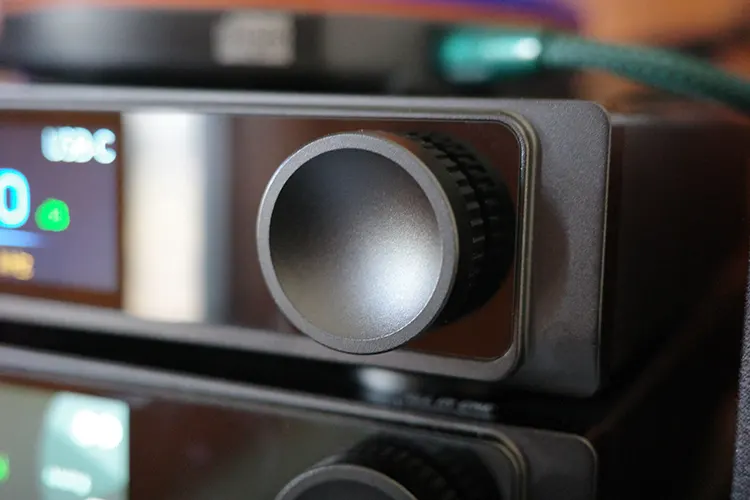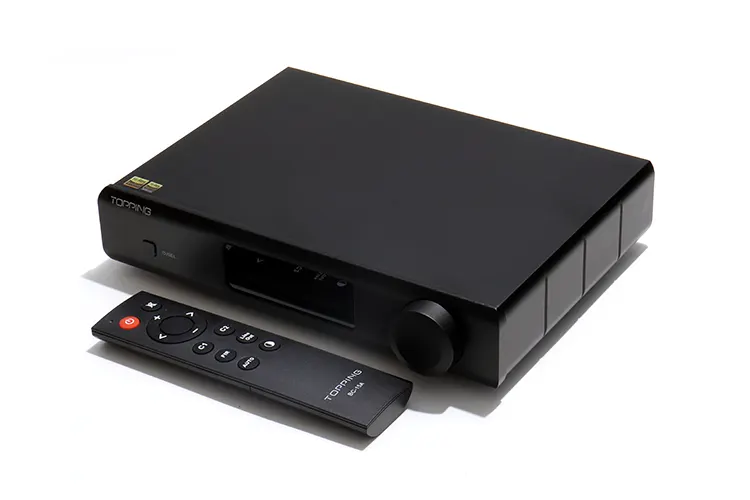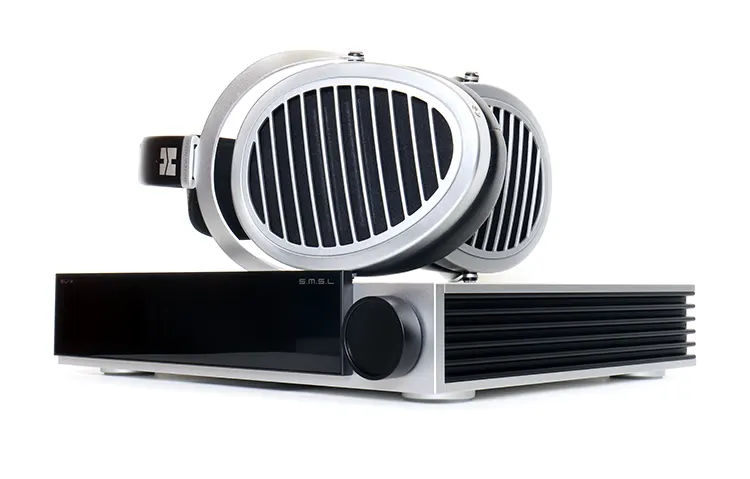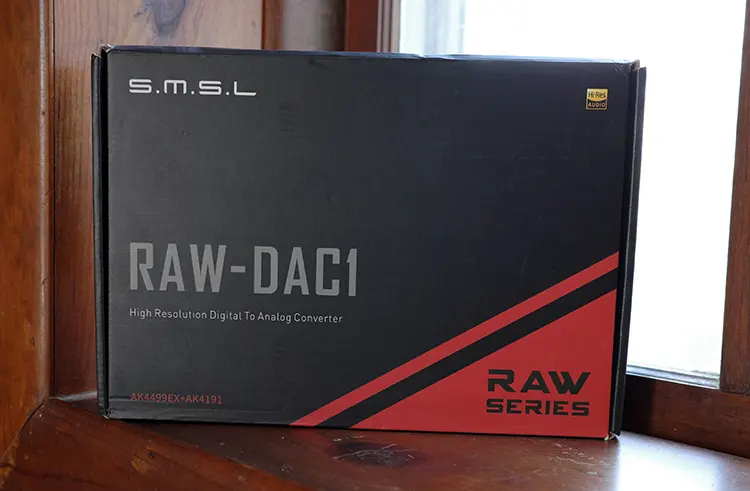Synergy
Efficiency
Since this is a dedicated DAC, the limitations lie within the amplification and source side of efficiency. While using the RAW-DAC1 as intended, I kept the volume at maximum using the amplified unit to raise or lower volume levels.
Filter/Soundcolor changes allowed for some fine-tuning within limitations.
Pairings
The SMSL RAW-DAC1 was equally at home with its partner amplifier, the RAW-HA1, and powered speakers. No matter the option, the RAW-DAC1 raised the sound quality of all used.
Pairing the RAW-DAC1 with the RAW-HA1 for the majority of the review, I utilized the two-channel speaker wiring of the RAW-HA1.
The HA1 is a much better two-channel amplifier than a headphone amplifier, in my opinion. As such, pairing it with the budget Yamaha bookshelf speakers afforded me time to gauge the sound.
The increase in clarity and levels of detail wrought from the pairing was markedly higher than the HA1 alone, which has a decent DAC inside. With the ability to alter the sound, the trio easily filled the listening room with details galore.
Paired to an upcoming review amplifier allowed me to compare this DAC to the internal one from that amp while utilizing the XLR out and XLR headphones.
When paired with the Edifier R1280DBs, I found the bass tightened up with an additional thump, too. While the Edifiers are budget-minded powered BT speakers, they are quite adept at representing a good listening session.
The treble moved up a bit in reach with a sparkle that Bluetooth from a source could not match. I gained a new appreciation for the Edifiers, noting this increase in sound detail as a result of the pairing.
Bluetooth from the FiiO TT13 into the RAW-DAC1 was seamless in connection. Running the RAW-DAC1 out to the RAW-HA1, then Yamaha speakers gave excellent results.
Strictly running the HA1 from the TT13 was quite nice, but the RAW-DAC1 raised the level of detail and clarity while keeping the low end under control. I also found that the finer microdetails from the vinyl played came through with a more succinct level of control.
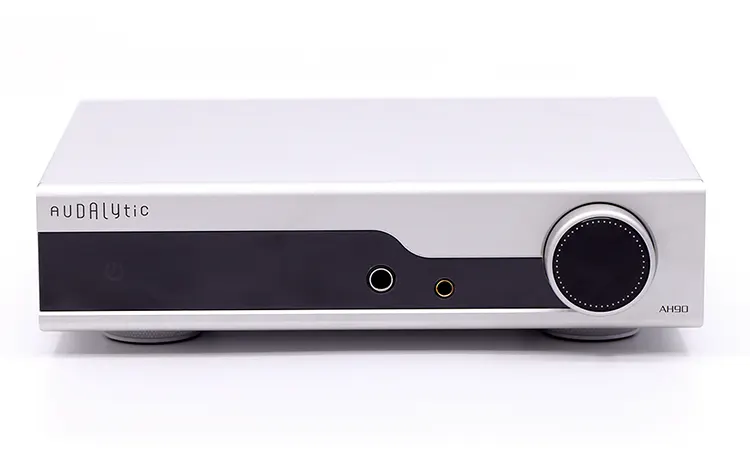
Select Comparisons
Audalytic AH90
Features
The Audalytic AH90 is a standalone midrange desktop DAC using the AKM AK4499EX DAC and AK4191EQ modulator chipset, separating digital and analog circuitry and isolating the signal from external interferences. The RAW-DAC1 does the same, using the same AK4191+AK4499EX chipsets.
Both carry the third-generation 16-core XMOS XU316 USB interface, and both support USB-C decoding high-resolution audio streams of up to PCM 32BIT/768 kHz, native DSD512, and MQA/MQA CD.
Combining all of this, both present a clear sound with accurate decoding, which translates into a smooth, accurate signature. The AH90 does come across as smoother, while the RAW-DAC1 is slightly more accurate.
Design
The AH90 comes in either silver or black, with a curved glass insert. The silver was shipped to me, offsetting the majority of the black boxes I currently have. To me, the silver shows the shape better, and it is easier to read the LCD, along with the other functions.
It has a design similar to the Gustard A26 and R26 (curved glass effect) and comes across with a fairly diminutive footprint that is very similar to the RAW-DAC1.
The AH90 measures 220mm x 170mm x 50mm with a minimal 2kg weight, versus 219 x 180 x 45 mm (W x H x D) 1.33 kg for the lighter SMSL model.
A large knob dominates the right side of the front on both, but other than the touch-sensitive on/off “button” that knob similarly controls all features of the RAW-DAC1.
The use of the knob was direct and without any faults or construction snafus. The design is elegant and functional yet carries a modern look to it as well. While I put it slightly ahead of the RAW-DAC1, the remote makes up the difference.
The AH90 can easily slip under your desktop monitor or next to your system, minimizing its presence while doing so, but with its good looks, you may want to showcase it instead.
Performance
Burr Brown DACs are known for a smooth relaxing signature, and the AH90 is no different. While the sound emanating from within is indeed smooth, there is still plenty of detail wrought from the sound signal.
The RAW-DAC1, on the other hand, comes across as eminently neutral and detailed, even more so than the AH90.
Where smoothness rules the sound signature of the AH90, and with excellent sonic characteristics, the clarity of the RAW-DAC1 shines through more than a smooth character.
The Audalytic would not be considered a reference sound or full of detail, but neither is it a slouch where clarity and retrieval are concerned.
The RAW-DAC1 could be considered the reference for the mid-fi DAC market. Both are very pleasant to listen to, but in many different aspects.
Topping D90 III Sabre
Features
The Topping D90 III Sabre uses a dual ESS ES9039SPRO setup as opposed to the AK4191+AK4499EX chipsets in the RAW-DAC1. For noise, the ESS chips win, but the sound is not based upon that alone.
The D90 III Sabre is one of the best-measuring DACs around and is certainly Topping’s best up-to-date when it comes to specifications and sheer performance numbers.
The progress forward shows that SMSL knows a thing or two about measurements, too, with the RAW-DAC1 coming close in many aspects.
The D90 III DAC is capable of reaching 32BIT/768kHz for PCM via USB and the ISS inputs, just like the RAW-DAC1. Native DSD up to DSD512 for both completes the list of compatible lossless formats.
Design
The D90 III Sabre is metal from front to back, most likely aluminum. No sharp edges and corners that are rounded and smooth finish a stylistic look. Both share the familiar black styling, with smart rather than elegant looks.
The overall design is minimalistic upfront but packed full of connections in/out on both back panels.
There’s a sole button and a volume Kob upfront, plus the digital display, which sits in the center, that is very similar to the SMSL. The back is covered in IO ports, the power receptacle, and the main power switch.
The volume knob has a press-to-activate feature and has indents as you make adjustments. Mechanically accentuated volume controls on both rule the front, but most times, you’re just going to set it at 0 decibels for use with an amplifier.
Performance
The Topping D90 III Sabre is a DAC with a sound signature that supplies the listener with a linear frequency response while supplying a fast-acting characteristic and speedy delivery of the source content. The same can be said of the RAW-DAC1, with a bit more expansive sound to it.
Levels of detail and clarity could be argued until we are blue in the face with no winner. Where some may prefer the ESS chips known for clarity & detail, the SMSL does not falter in the competition.
The D90 III portrays a super clean translation that comes through as fluid and crystalline. The RAW-DAC1 also carries that crystalline note to it. The overall sonic representation on both is cool, lively, and highly detailed, with a silent background and a quick-acting transient response.
If there is one discernible difference, it would be the bass. Where the Topping lies on the thinner side, with excellent control, the SMSL comes with more weight to the low end but with slightly less control.
The D90 III DAC produces a high level of resolution, producing sharp, defined elements alongside a natural overall tonal character that will complement any amplifier and headphones you might have.
The more neutral RAW-DAC1 plays just as nicely, complementing the amplifier of choice without hindering what we hear.
SMSL SU-X
Features
The SU-X also runs the ES9039MS PRO chipset in a dual configuration. The AK4191+AK4499EX chipsets in the RAW-DAC1 provide another option from the company’s DAC list.
SMSL developed their proprietary multi-frequency CK-03 Jitter processing circuit stage to manage the timing and keep Jitter at zero. This carries over into the RAW-DAC1.
The USB input stage uses the 3rd generation XMOS XU-316 true 32-bit USB solution, which also carries over into the RAW-DAC1.
The SMSL SU-X handles PCM playback up to 32BIT/768kHz and up to DSD512 natively, just like the RAW-DAC1.
Design
The SMSL SU-X’s overall design is a robust one made from a thick sheet of aluminum and a thick sheet of tempered glass up front. Large metal fins occupy the side panels, and the overall package is a hefty 5.9 pounds or 2.7 kilograms, twice as heavy as the RAW-DAC1.
The cabinet body is grey while the multifunction volume knob, the side panels, and the tempered glass are all finished in black, as opposed to the RAW-DAC1’s all-black color.
It’s a good-looking, industrial, sleek design, and the only aspect I would change would be to add some kind of ventilation since the unit does get warm at times. Since it is a stand-alone DAC, this is less important to me, and the RAW-DAC1 doesn’t have vents, either.
One positive note is that the thickness of the aluminum is such that it naturally makes this cabinet impervious to stray radio frequency signals. You can place your mobile device directly on top of this unit, for example, and you will hear nothing but silence.
If this were on looks alone, the SU-X would not lose this competition.
Performance
The ideal pairing with the SU-X is with the SMSL SH-X desktop amplifier, much like the complimentary RAW-HA1 for the RAW-DAC1. That said, the sheer versatility of both makes for some fun pairings.
The natural timbre of the SMSL SU-X is one of its best characteristics. It strikes a balance between smooth and ardent that presents the listener with quite an accurate translation of what’s in a recording. And better the RAW-DAC1 only slightly, but a more emotive effect.
The SU-X also tries to extract every detail within a recording, and it does so successfully. Where the Topping listed above might have struggled a tiny bit, the SU-X carries forward without a bother.
The familial resemblance between the SU-X and the RAW-DAC1 is probably most evident in terms of resolution and transparency.
A high amount of micro-dynamic representation is brought forth along with all the other elements in a coherent manner in both, but it is slightly better than in the SU-X. The overall sonic signature is linear in frequency response and detail-rich in both.
My Verdict
From the last comparison, it is fairly obvious that the SMSL RAW-DAC1 follows in the footsteps of the excellent SU-X DAC. With very good detail retrieval and somewhat crystalline clarity, the RAW-DAC1 presents an eminently musical tone to the source, no matter what it is.
I had equal fun and appreciation for use with headphones through the upcoming review amplifier or two-channel systems.
My only caveat would be that you do not match it with an amplifier that carries too much power when in use with IEMs, lest you continue to turn the volume up because the trio comes across in such a good manner.
For this price, and with this set of features, I cannot come up with any discrepancies other than maybe making the digital screen more readable in both options and more output options. But those are minor.
The SMSL RAW-DAC1 carries the RAW nomenclature for a reason: it means business. And it gets that business done superbly, with excellent sonic characteristics coming across as extremely musical and detailed.
The clarity of presentation finished the deal, making the SMSL RAW-DAC1 an excellent option for anyone looking for a dedicated DAC that carries a multitude of input options.
SMSL RAW-DAC1 Technical Specifications
- Inputs: USB, Optical 1, Optical 2, Coaxial 1, Coaxial 2, IIS, Bluetooth
- Output: XLR, RCA
- Output Amplitude: XLR: 5 Vrms, RCA: 2.5 Vrms
- THD+N: 0.000006% (-124dB) (UN-WTD)
- Dynamic Range: XLR: 132 dB, RCA: 127 dB
- SNR: XLR: 132 dB, RCA: 127 dB
- USB Transmission: USB 2.0 (asynchronization)
- USB Compatibility: Windows 7/8/8.1/10/11 (Needs Driver), Mac OSX 10.6 or above, Linux (Driverless)
- MQA Decoder: USB, Optical, Coaxial
- Power Consumption: <10W
- Standby Power: <0.5W
- Size: 219 x 180 x 45 mm (WxHxD)
- Weight: 1.33 kg / 2.93 lbs
Sampling Rate & Bit Width:
- USB: PCM: 44.1 ~ 768 kHz (32 bit), DSD: 2.8224 ~ 22.5792 MHz (1 bit), DoP: 2.8224 ~ 11.2896 MHz (1 bit)
- Optical/Coaxial: PCM: 44.1 ~ 192 kHz (24 bit), DoP: 2.8224 MHz (1 bit)
- Bluetooth Specification: Version 5.1 (Supports SBC, AAC, aptX, aptX HD, LDAC)


